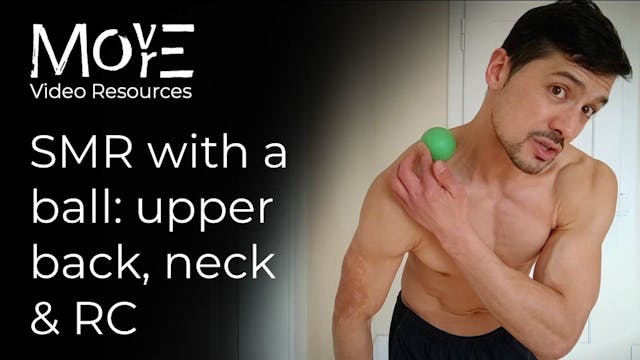SMR protocols for habitual kyphosis
Manual-therapy & self myofascial-release (SMR)
•
19m
THE WHAT:
Fundamental protocols for SMR (self-myofascial release) with focus on areas which, when in a hyper-tonic state, contribute to a 'kyphotic' posture. Commonly caused by work, practice, & life habits, the perspective of 'habitual' kyphosis means that it is your movement HABITS which must be managed for there to be improvement. These tools alone will NOT improve habitual kyphosis and are presented as both accessory, as well as therapeutic, tools only.
The best wat to determine if you need this protocol at this point in time is to try it and feel for yourself. If there is any significant pain anywhere (give special attention to the anterior shoulder/biceps tendon), then you should focus on that/those area/s with daily rolling until the tissue quality improves. Ultimately, well-maintained tissue free of excessive tension should not hurt to the touch. Be sure to follow the protocols as described - simply rolling up and down, as is the popular image of the "foam roller" - will do little for managing tension in & quality of tissues.
Although these protocols can give immediate relief to superficial shoulder restrictions, I strongly advise NOT to simply perform it in isolation as, without further stimulus, the tension relieved will likely return within a few hours or less. Example sequence:
A1. 5-20 mins SMR
A2. 2-3 mins of arm patterns (waves, circles, figure-8's, 'teacups'...)
A3. 60"+ accumulated hanging variations: https://youtu.be/AMrUkViLebM
(1-arm passive and 2-hand supinated are particularly valuable loaded stretches here for the lats & pec minor. If you have hypermobile/'unstable' shoulders, incorporate 'active' hanging also).
A4. Contract/relax shoulder-stretches in select positions (focus on "opening" the chest and anterior shoulder, e.g. A1. Overhead 'Y' position in a doorway, A2. 'Cross' position in a doorway, A3. supine 'table' position on all 4's, arms extended behind). Go with 6x 5-10" contractions each side in each range you choose).
Once you feel the tissue quality has improved (i.e. holding less tone), this SMR protocol has served its purpose and you can simply continue with A2. and A3. in combination with any other accessory mobility work you are performing to develop these ranges. Revisit the protocol at any time you recognise superficial tension developing/being help in the areas symptomatic of habitual kyphosis.
_______________________
For programming, guidance, & support for your physical practice:
FREE fundamental prehabilitation program: https://www.movemoremp.com/
Online Support (1 to 1 coaching): https://movemoremp.com/onlinesupport/
Elements (standardised programs): https://www.movemoremp.com/elements-store/
[email protected]
Up Next in Manual-therapy & self myofascial-release (SMR)
-
SMR for scapulae & spine
THE WHAT & HOW:
Another fundamental resource for diagnosing, treating, and mitigating hypertonicity in areas of the body which can commonly hold a greater than desirable level of resting tone. Whether from lifestyle or practice habits, if left untreated, what can begin as "superficial-blockages" ... -
SMR using a tennis/rubber ball
THE WHAT & HOW:
Another fundamental resource for diagnosing, treating, and mitigating hypertonicity in areas of the body which can commonly hold a greater than desirable level of resting tone. Whether from lifestyle or practice habits, if left untreated, what can begin as "superficial-blockages" ... -
SMR for lateral deltoids
THE WHAT & HOW:
Another fundamental resource for diagnosing, treating, and mitigating hypertonicity in areas of the body which can commonly hold a greater than desirable level of resting tone. Whether from lifestyle or practice habits, if left untreated, what can begin as "superficial-blockages" ...



